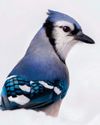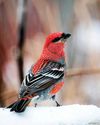Intentar ORO - Gratis
How Owls Use Their Impressive Adaptations After Dark
Birds & Blooms
|October/November 2019
Learn how owls use their impressive adaptations after dark.

Whether in a patch of dense woods or in a suburban yard, owls use their unique and spectacular abilities to master their environment. And all their senses come together to help them thrive when most animals are sound asleep.
What a Sight
Take one look at an owl and you can see why vision is one of its sharpest senses.
“They have large eyes for their body,” says Lori Arent, assistant director of the Raptor Center at the University of Minnesota. “They take up something like 3% of their body weight. For humans, it’s far less than 1%.”
Their peepers are so large that they’re fixed in the eye sockets for support, so owls can’t move their eyes more than a degree or two. To compensate for that limited eye motion, owls are able to turn their heads 270 degrees.
Esta historia es de la edición October/November 2019 de Birds & Blooms.
Suscríbete a Magzter GOLD para acceder a miles de historias premium seleccionadas y a más de 9000 revistas y periódicos.
¿Ya eres suscriptor? Iniciar sesión
MÁS HISTORIAS DE Birds & Blooms

Birds & Blooms
Ready to Fly
For birders, spring migration is something to look forward to and be celebrated, but how do birds know when it's time to begin their travels?
2 mins
December 2025 / January 2026

Birds & Blooms
COOL AS A Camellia
When temperatures drop, most plants wait out the chilly months, but camellias put on a show. Discover how to have these beauties thriving in your yard.
2 mins
December 2025 / January 2026

Birds & Blooms
Festive Feathers
Readers braved the winter chill to capture these snowy snapshots of the season's most beautiful birds
2 mins
December 2025 / January 2026

Birds & Blooms
Winter Gems
With raspberry-red feathers, pine grosbeaks cheer up chilly landscapes wherever they land
2 mins
December 2025 / January 2026

Birds & Blooms
the mysterious lives of NIGHTHAWKS
These creatures of contradiction aren't hawks and aren't the most active at night, but they are worth knowing
3 mins
December 2025 / January 2026

Birds & Blooms
Adventure Awaits
Pack your bags, get on board and find your next vacation destination in these captivating photos from far-flung travels
2 mins
December 2025 / January 2026

Birds & Blooms
It's All in the Needles
Get to know the greenery to identify these conifers
1 min
December 2025 / January 2026

Birds & Blooms
Christmas Tree Do's and Don'ts
These pro tips will help you get the most out of this classic holiday fixture
2 mins
December 2025 / January 2026

Birds & Blooms
Trailing Houseplants
Simple, easy-to-grow plants for hanging containers
3 mins
December 2025 / January 2026

Birds & Blooms
Better Off with Bats
Rethink the unsung heroes of the night and why you should support them
2 mins
October / November 2025
Translate
Change font size
